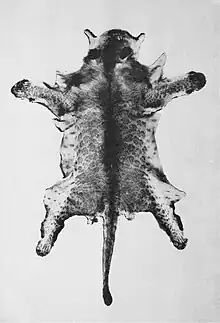The marozi is a name given to a type of spotted feline similar to a lion but with leopard-like spots, which was sighted in Kenya in the early 20th century. A scientific name, Panthera leo maculatus, was given, but the marozi has not been confirmed to be a species or subspecies of its own, rather than an unusual colour morph of the African lion (P. l. leo), or a naturally occurring pantherine hybrid. Skins of hunted specimens fitting the description do exist, but have not been sufficient for biologists to come to any definite conclusion regarding the nature of the animal.
Though various theories have been advanced, the general consensus seems to be that the mazori is a colour morph of a known subspecies of lion, perhaps involving individuals that retained juvenile spots into adulthood.[1]
Etymology
Marozi, from Kikuyu language means "spotted lion" because of natural spots in their skin of the lion.
Claims

Though there were local East African legends of spotted lions, the first sighting documented by westerners was from Colonel Richard Meinertzhagen in 1903, who discussed seeing dark lions with rosette-like markings in the mountains of Kenya. Meinertzhagen had previously heard of the spotted lions, but may not have taken this very seriously.[2]
Another incident was in 1931, when a white farmer, Michael Trent, shot and killed two individuals, a male and a female, in the Aberdare mountains at an elevation of 10,000 feet (3,000 m). The unusual spotted markings on what seemed to be smallish adult lions prompted interest from the Nairobi Game Department; they were from adult lions and yet had prominent spots that are typical only of cubs, and the male lion's mane was insignificant. The department lacked sufficient skeletal evidence to definitively prove the species or age.[2]
Two years later, explorer Kenneth Gandar-Dower headed an expedition into the region in an attempt to capture or kill more specimens.[3] He returned with only circumstantial evidence: three sets of tracks found at a similar elevation as Trent's lions (10,000–12,500 feet or 3,000–3,800 metres). They were believed to have been left by individuals that were tracking a herd of buffalo during a hunt, ruling out the possibility of the marozi being cubs. Gandar-Dower noted that while some adult lions did keep their rosettes, such lions did not have them to the same degree as the pelts.[2][4]
There were other sightings around the same time:
- Four animals sighted by Game Warden Captain R. E. Dent in the Aberdare Mountain region at an elevation of 10,000 feet (3,000 m).[2]
- A pair sighted on the Kinangop Plateau by G. Hamilton-Snowball at an elevation of 11,500 feet (3,500 m). They were shot at, but escaped.[2]
The presence of lions in an unusual habitat at a higher altitude than is typical for the species also suggested the possibility of a distinct population.[5]
Skepticism
In 1950, The Field published a discourse by W. Robert Foran, who was skeptical of the existence of a new race or subspecies of lion. He favoured the hypothesis that a small group of the Somali lion, Panthera leo somalica that included aberrant spotted individuals had migrated to Kenya to the Aberdares.[6] Author Noel Simon commented in 1962 that the consensus of opinion about sightings of marozi is that they are "plains lions which have retained their cub spots into adult life".[7]
In 1963, zoologist Charles Albert Walter Guggisberg claimed that there is no reliable evidence for the marozi as a distinct variety of lion, saying, "...to this day nobody has been able to produce any proof of its existence. In East African lions the juvenile markings do not fade for quite a number of years, and I myself have seen two - year - old lions on the Athi Plains, showing just about the same rosettes as can be seen on the famous skins from the Aberdares."[1]
See also
References
- 1 2 Guggisberg, Charles Albert Walter (1963). Simba, the Life of the Lion. Chilton Books. p. 50.
- 1 2 3 4 5 Hartwell, Sarah. "MUTANT BIG CATS - SPOTTED LIONS". Messybeast. Retrieved 2023-07-30.
- ↑ "But He Never Found a Spotted Lion". nytimes.com. Retrieved 16 December 2023.
- ↑ Gandar-Dower, Kenneth (1937). The Spotted Lion. William Heinemann Ltd. – via HathiTrust Digital Library.
- ↑ Smith, Duncan JD (June–July 2018). "Driven By Devils: The Remarkable Story of KC Gandar-Dower" (PDF). Old Africa. No. 77. pp. 8–12. Retrieved 2024-01-11.
- ↑ Foran, W. Robert (1950). The Legendary Spotted Lion. The Field. p. 535.
- ↑ Simon, Noel (1962). Between the Sunlight and the Thunder: The Wild Life of Kenya. Collins. p. 315.